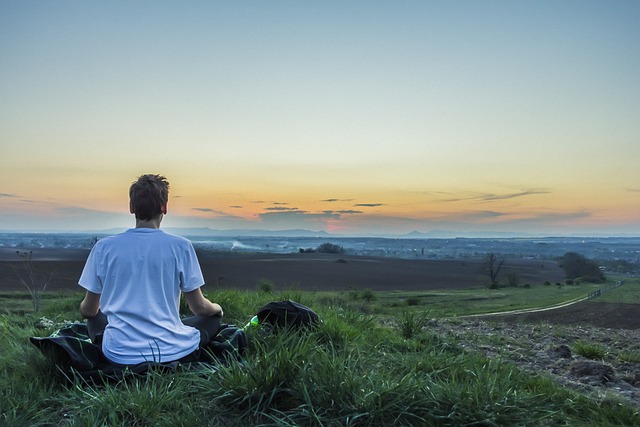Vy Van Le provides a guided meditation podcast focused on becoming reacquainted with your body as part of the Mindful Awareness Research Center (MARC) weekly meditation sessions conducted in person at the Hammer Museum and online via Zoom. Vy is a highly qualified mindfulness trainer and coach who facilitates the Mindful Awareness Practices Classes at MARC, UCLA.
Vy’s background before becoming a mindfulness practitioner and trainer was in maths, biotech business development and management consulting. Through mindfulness practice and training, she realised that she spent so much time in her head, disconnected from her body. She could relate to James Joyce’s comment in Dubliners , “Mr. Puddy lived a short distance from his body”. This realisation led her to focus on embodiment mindful practices and to provide mindfulness training to individuals of all ages ranging from teenagers to retirees, as well as professionals particularly those in healthcare.
Vy contends that we are often numb to our bodies and that it is important to cultivate a relationship with our body and the intuitive wisdom and “gut feeling” of our body. She maintains that the body is a doorway to the present moment and bodily awareness is a means of developing self-compassion and aliveness. Vy argues that somatic meditation can help us to achieve a genuine connection with ourselves in a world where disconnection is a source of widespread depression, anxiety and suicidal ideation.
Guided meditation for resting in your body
In the guided meditation podcast, Vy encourages you to concentrate on bodily sensations as you undertake a body scan. Her scan process is focused more on awareness of bodily sensations than release of related tension in specific bodily parts. However, one of the participants in her recent meditation session commented that “her shoulders were relaxed by the end of the meditation”, instead of raised in a tense position “as if carrying the weight of the world”.
Vy encourages you to progressively scan your body which is something that you can do at anytime or anywhere. You might, for instance, notice the following sensations in parts of your body indicated below;
- Thighs – the pressure from your chair or floor; muscle movement or tautness; sense of being held up/supported
- Feet – sense of groundedness and connection to the earth; swelling or numbness; soreness from walking or running
- Toes – tingling; flexing; cramping; alive or lifeless
- Shoulders – soreness; stiffness; arched or compacted; strong or week
- Fingers – tingling; stiffness; knuckle soreness; sense of control
- Forehead – tightness; creasing; pain; agitation; clarity or calmness
- Arms – muscle twitching; aches; sense of strength and self-reliance
- Knees – softness behind the knee; soreness or tingling; sense of being supported
- Chest or abdomen – the rise and fall with breathing; tight or relaxed
- Nose – warmth or coolness from the in and out breath; blocked or open.
Your breath, feet and fingers can be anchors in this developing sea of awareness about your body. You can re-focus on any of these aspects if your mind becomes a source of distraction. Repeatedly returning to an anchor develops your awareness muscle and heightens your connectedness to your body.
While it is useful for you to undertake this form of body scan meditation yourself as a regular practice, it is really helpful in establishing the practice to be guided by a skill facilitator like Vy. This enables you to concentrate on your inner and outer bodily sensations and not have to think about the next step – to just go with the flow of her guidance.
Reflection
I found this guided meditation, led by Vy, to be particularly restful. It developed a sense of resting in my body, away from the thoughts and cares of the world. There is something peaceful and encouraging about being fully connected with your own body. In lots of ways, this body scan meditation can be a source of refuge in difficult times. It is amazing how often we ignore our body – even trying to “soldier on” when we are experiencing post-traumatic stress effects from adverse childhood or adult experiences.
Oprah Winfrey provides evidence of this “masking” in her co-authored book, What Happened to You?, when she quotes a discussion with Cynthia Bond, author of Ruby, Cynthia described the devastating impact on her whole life and career from trauma, including sexual abuse as a child. Cynthia explained that she tried unsuccessfully to “bury it”, hoping “that the ache would go away”.
The guided scan mediation offered by Vy helps us to grow in mindfulness – to become increasingly self-aware in relation to our body, to develop a sense of self-gentleness and self-compassion and to become more fully alive and present to our current reality.
I realised during the course of the guided meditation that my mindfulness practice when waiting, e.g., at traffic lights, is a form of embodied meditation. Instead of becoming annoyed with the traffic or particular drivers, I focus on my joined fingers that are resting on my lap and concentrate on the sensations I am experiencing through my fingertips, e.g., warmth, tingling, blood flow, and soreness (sometimes). This embodied practice is really grounding for me and increases my bodily awareness.
Embodiment has become a strongly emerging theme in the mindfulness movement, e.g., The Embodiment Conference provides access to many experts in areas such as dance and creativity, yoga, trauma and social change, and movement and anatomy. Free access is provided from 10th-14th December 2022.
________________________________
Image by Benjamin Balazs from Pixabay
By Ron Passfield – Copyright (Creative Commons license, Attribution–Non Commercial–No Derivatives)
Disclosure: If you purchase a product through this site, I may earn a commission which will help to pay for the site, the associated Meetup group, and the resources to support the blog.
